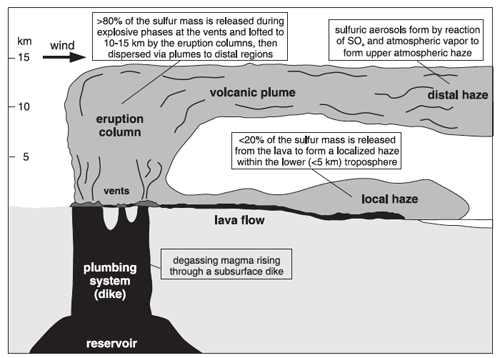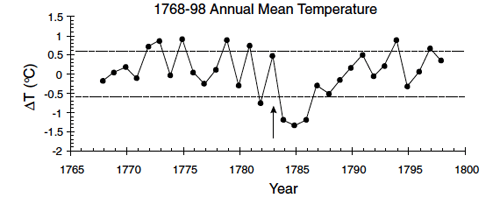The Skaftar Fires eruption was one of the five deadliest eruptions of the past 250 years. More than 9,000 people are estimated to have died within Iceland, nearly all due to starvation and disease in the months that followed the eruption itself. This accounts for ~20% of the population of Iceland at the time of the eruption, but the devastation was not limited to the island. Approximately 10,000-20,000 additional deaths across Europe in 1784 are attributed to respiratory ailments, a severe winter, and failed crops, which very likely were exacerbated by - if not entirely a result of - the Lakagígar eruption.
The Icelandic word móðuharðindin, meaning “mist hardships”, is used to describe the difficult times following the Lakagígar eruption. Acid rain destroyed crops and about three quarters of the island’s livestock. Animals that grazed on plants or drank from rivers contaminated with volcanic fluorine developed skeletal fluorosis, making it painful to eat or move. Sulfur is a minor component of the Earth’s mantle that tends to be concentrated in basaltic magmas. When basalt erupts as lava above the surface, the large pressure decrease allows the sulfur to be released in the form of sulfur dioxide (SO2) – the process is similar to the way carbon dioxide is released from a bottle of soda when you reduce the pressure by removing the lid. Scientists estimate that ~122 megatons of SO2 were released during the Lakagígar eruption. Upon combining with water in the atmosphere, this would have been converted to ~200 megatons of atmospheric aerosols, which were predominantly H2SO4. A little less than 20% of these aerosols are released from the lava flows and remain close to the surface as a local haze, while the remaining ~80% are carried up into the lower stratosphere by the eruption column (fire fountains and phreatomagmatic events) and transported over long distances by atmospheric circulation.

Of the total aerosols that were produced during the Lakagígar eruption, almost 90% would have fallen out as acid rain (mostly over Europe), with a little over 10% remaining in the upper atmosphere and circulating for several years. Aerosols in the upper atmosphere increase the Earth’s albedo (percent of the Sun’s energy that is reflected into space before reaching the surface), resulting in global cooling, usually on the order of ~1˚C, lasting for months or years. This effect is referred to as volcanic winter, and may last right through the summer growing season and into the next year. Coming on the heels of an unusually hot summer, the winter of 1784 was one of the coldest and longest winters on record in much of Europe and North America. Crop yield was extremely poor, and thousands of people died of starvation.
